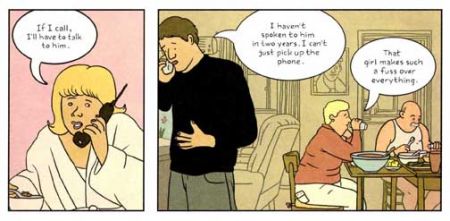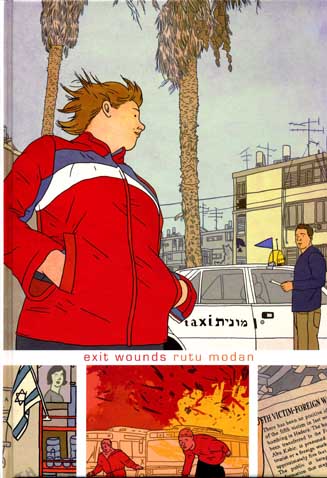Comics /
Comic Reviews /
More Comics
Rutu Modan's Exit Wounds
By Henry Chamberlain
August 18, 2008 - 09:35
"Remember that suicide bombing in Hadera three weeks ago?"
"Hadera? You mean Haifa."
"No, not the one at the restaurant. The one in the bus station cafeteria."
And so begins a matter-of-fact exchange about suicide bombings between a malcontent taxi driver and a young woman finishing up her Israeli military service and aching to begin her life. This is what sets up the premise for Rutu Modan's graphic novel,
Exit Wounds. Rutu Modan has been tapping into the Israeli psyche with her comics all her life. She has won many awards along the way with
Exit Wounds winning the
Eisner Award for Best New Graphic Novel in 2008.
The first page of
Exit Wounds places us in what seems a typical city scene: Tel Aviv, January 2002, 9:00 AM. It could be any city full of infrastructure, people, a sleepy cab driver oblivious to an office worker hailing him over. The next couple of pages set up specificity. This cab driver is Koby and he's picking up his aunt and uncle, Ruthie and Aryeh. Aryeh just got out of the hospital and Ruthie is suppose to relieve Koby from his shift as cab driver but she'd rather watch "The Young and The Restless." They all live together. Very hum drum. Then, in an instant, Koby's life will take a turn when he's dispatched by his supervisor to meet someone in particular. This turns out to be, Numi, that young woman who brings up the subject of suicide bombings.
 |
| Exit Wounds: Deep in Conversation. |
By Page 20, the plot has thickened with four characters engaged in conversation over the possibility that Koby's father is missing as suggested by Numi. Koby is on the phone with Orly, his sister in New York, while Ruthie and Aryeh react to scraps of overheard conversation and argue over warmed over soup. The alternating rythym of panels, going back and forth between a square for Orly and a rectangle with Koby in the foreground and Ruthie and Aryeh in the background is a fine example of the impeccable pacing throughout this book.
The gravitational pull toward a homey existence is ever present for Koby. A quiet life has won by default. The deadpan thin line art fits right in with this desire for restraint. Once, Numi enters Koby's life, who he derisively calls "the giraffe," he is never left to daddle. Numi has also been stuck in a rut without any promise of escape until she meets Koby. Now, the thin line art expresses a growing tension in need of resolution.
Looking back at one of Rutu Modan's earlier works, "The Panty Killer," part of a box set created for the artist collective,
Actus Tragicus, which Modan is a cofounder, I see that same care for details in character and local color as in her latest book. It is interesting how both stories revolve around a mystery. And it is gratifying to observe her style and vision evolve to such a level of refinement.
Exit Wounds, as the title makes clear, is about what happens after an act of violence. Rutu Modan has created a powerful story, without hyperbole, or self-indulgence. Her strong sense of place has provided us with a window into Israeli life and a comics masterpiece that will endure.
Last Updated: August 31, 2023 - 08:12

